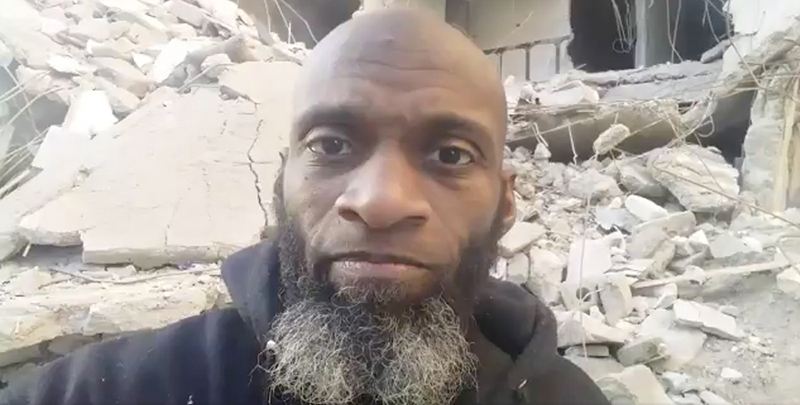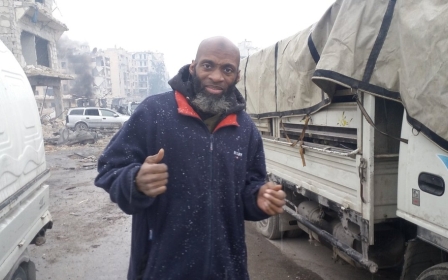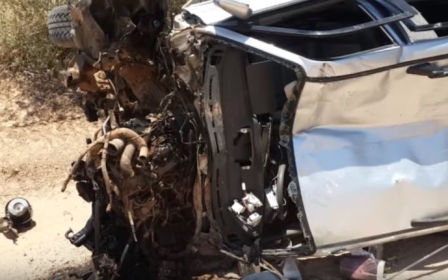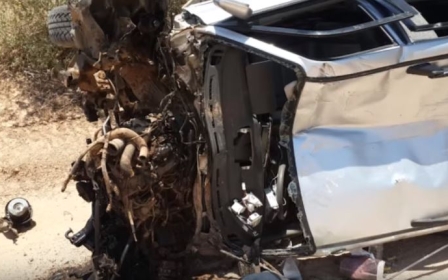US 'kill list': Five times Bilal Abdul Kareem narrowly escaped death

Syria-based US journalist Bilal Abdul Kareem on Thursday filed a lawsuit accusing the US government of placing him on an alleged "kill list".
Abdul Kareem in the lawsuit, which was filed against US President Donald Trump and other senior officials, alleged that the US had tried to kill him five times using air strikes in mid-2016, killing at least three people including a 10-year-old girl in the process.
The lawsuit was also filed in the name of Ahmad Zaidan, a former Islamabad bureau chief for Al Jazeera Arabic, and states that the pair were "targeted for death" after being identified by a US surveillance program called SKYNET which selects potential targets for drone strikes based on metadata and mobile phone records.
Abdul Kareem, an occasional Middle East Eye contributor, told MEE on Friday that "well-placed sources have informed me that I have been included on the drone list for flights that take off from the Incirlik airbase in southern Turkey".
Incirlik is used by US forces carrying out air strikes against the Islamic State (IS) group and other Syria-based armed groups.
Neither the CIA nor the National Security Agency (NSA) have so far commented on the allegations but officials familiar with the procedure by which the US government selects targets told the New York Times newspaper they were sceptical that either Abdul Kareem or Zaidan was on the kill list.
The lawsuits state that "While plaintiffs were placed on the Kill List by his predecessor [Barack Obama], on information and belief, defendant Trump has continued to include them on the Kill List and has, in addition, removed certain restrictions and criteria previously employed in the designation of persons to be included on the Kill List".
The lawsuit includes details of five air strikes in 2016 when Abdul Kareem believes he was targeted by the US, including a drone strike on 26 June when his car was destroyed by a Hellfire missile. Describing the incident to MEE at the time, Abdul Kareem said: "As we are sitting there in the car, all of a sudden everything goes black.
"I thought they had hit the earth and the earth had split and the car was falling into the earth. But what was happening is that when the car was hit, it went airborne, flipped over and it pointed us in the opposite direction on its side."
The lawsuit states: "Upon information and belief, plaintiffs allege that Abdul Kareem was the specific target of the strikes discussed [below] and that those strikes were carried out as a result of Abdul Kareem’s inclusion by defendants on a US Kill List."
Idlib City, early June 2016
Abdul Kareem, who had been out filming with an On The Ground News crew, returned to the office. He heard aircraft approaching. With the others who accompanied him, he ran inside. The strike hit the OGN building. The studio is underground and the whole building, including the office, shook.
Hariyataan, near Aleppo, early June 2016
Abdul Kareem was with his cameraman standing outside filming in the street. Abdul Kareem asked the cameraman to go a bit further down the street and set up from the other side so he could film Abdul Kareem and the person who he was interviewing talking and walking up the street. He had arranged to interview a local man who owned a supermarket. There were drones buzzing above. As they started walking up the hill to view destroyed homes a street away, there was a loud explosion. When they returned, the area where they had been standing and filming was a wasteland. There was still fresh smoke in the air and shrapnel all around.
Khantounam, 26 June 2016
The vehicle of Abdul Kareem and his staff was struck and destroyed by a drone-launched Hellfire missile. Abdul Kareem had noticed that a drone had been circling the area where he and his team had been filming. When the strike occurred, Abdul Kareem was sitting in a pick-up truck, parked under a tree, and the others were in an On The Ground News vehicle. All of a sudden, everything went black. Abdul Kareem had been facing in one direction towards the tree, and suddenly the vehicle was flipped upside down. The vehicle had been hurled into the air by the force of the blast; it turned over and also ended up facing the other way. Abdul Kareem only survived because he was wearing a bulletproof press vest.
Idlib City, 28 June 2016
Abdul Kareem’s office at On The Ground News was targeted. The missile that hit the building killed three civilians - a woman, her 10-year-old daughter, and an elderly man.
Kulliyatul Midfaiyyah, mid-August 2016
Abdul Kareem was at the Kulliyatul Midfa’iyyah – the Artillery College. He had gone there to film as the area had recently changed hands from government control to rebel hands. Abdul Kareem and three other people from On The Ground News were driving in Abdul Kareem’s car. They had almost arrived, but were still moving when there was a huge blast only yards away from the car. One person sitting in the back of the car got shrapnel in his ear. Abdul Kareem and the others were all picking glass and steel out of their skin for some time after.
The lawsuit can be read below.
New MEE newsletter: Jerusalem Dispatch
Sign up to get the latest insights and analysis on Israel-Palestine, alongside Turkey Unpacked and other MEE newsletters
Middle East Eye delivers independent and unrivalled coverage and analysis of the Middle East, North Africa and beyond. To learn more about republishing this content and the associated fees, please fill out this form. More about MEE can be found here.




